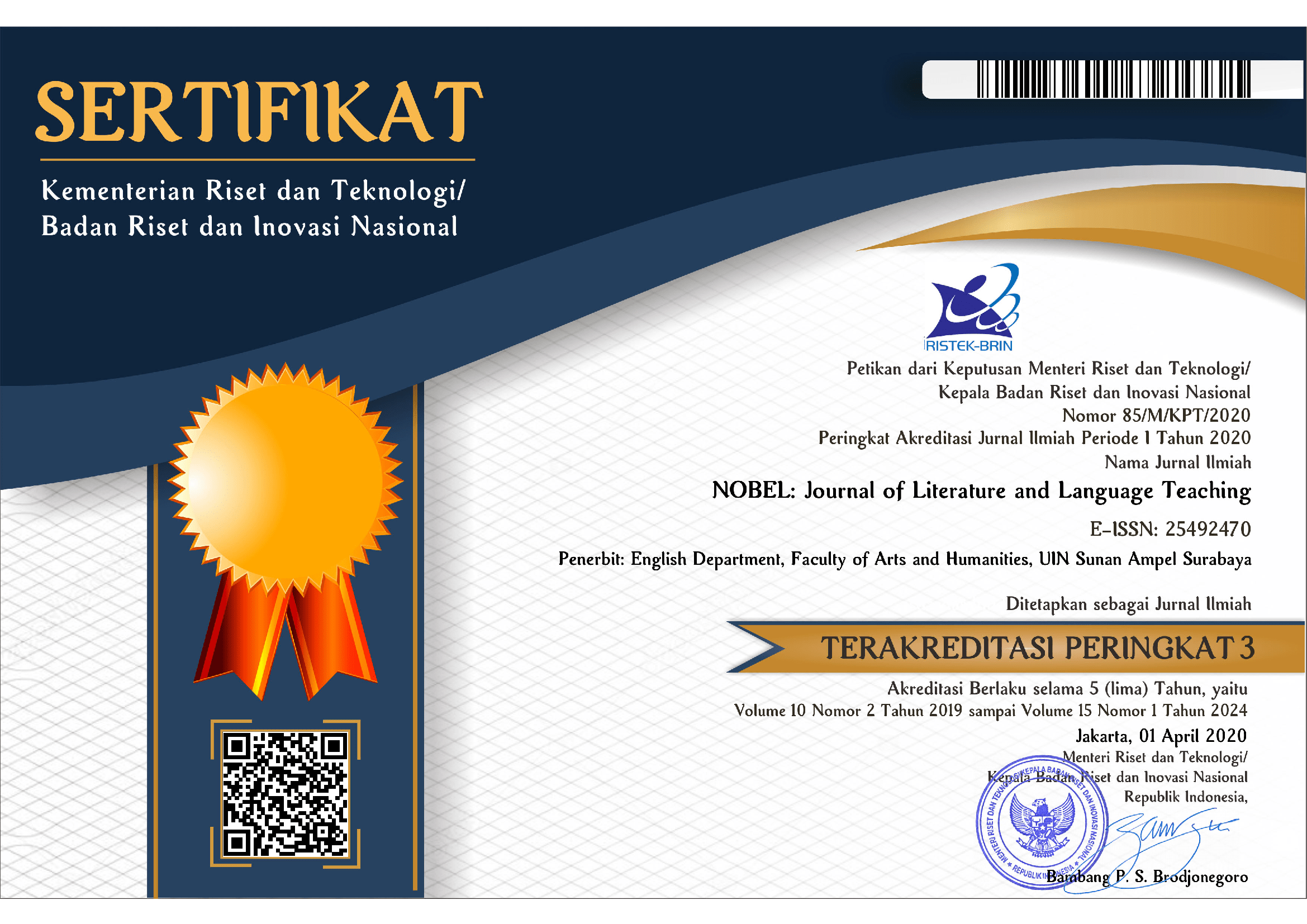Muslim Women Representation in Zoya Hijab Video Advertisement
A Multimodal Analysis
DOI:
https://doi.org/10.15642/NOBEL.2021.12.1.136-157Keywords:
gender, multimodality, representation, advertisement, Zoya hijabAbstract
Advertisement as a tool of marketing usually displays the best quality of products to be advertised through the best portrayal of the products and roles shown by actresses. Women's representation in media is often related to gender roles in society. Gender stereotypes often determine how men and women should behave in society. Our review of the previous research shows that there is an inconsistency in the representation of women in media and advertisements. The current research collected data from Zoya Hijab video advertisements to reveal Muslim women's representation in the advertisements. The data analysis was conducted by applying multimodal analysis using Kress and Van Leeuwen’s (2006) visual grammar and Halliday’s (1994) systemic functional linguistics. The research results show the portrayal of Muslim women in terms of physical appearance, occupation, behavior, and traits in the video advertisements
Downloads
References
Acevedo, C. R., Nohara, J. J., Arruda, A. L., Tamashiro, H. R. D. S., & Brashear, T. (2006). How women are depicted in ads? A content analysis study with Brazilian advertisements. International Business & Economics Research Journal (IBER), 5(10), 59-72. DOI: 10.19030/iber.v5i10.3517.
Abolaji, L. A. (2011). Gender ideology and social crises in Ifeoma Okoye’s Behind the Clouds and Men Without Ears. Doctoral Thesis. University of Illorin, Nigeria. Retrieved from https://www.unilorin.edu.ng/studproj/arts/
Aksu, B. (2005). Barbie against superman: Gender stereotypes and gender equity in the classroom. Journal of Language and Linguistic Studies, 1(1), 12-21. https://dergipark.org.tr/en/pub/jlls/issue/9921/122797
Ali, S & Shawar, D. (2011). Men, women and T.V. ads: The representation of men and women in the advertisements of Pakistani electronic media. Journal of Media and Communication Studies, 3(4), 151-159. http://www.academicjournals.org/jmcs
Brannon, L. (2004). Gender: Psychological perspectives. London: Prentice-Hall.
Correa, D. M. (2011). The construction of gender identity in India through television advertisement: a semiotic analysis. Doctoral thesis. Australian Catholic University Digital Theses. DOI: 10.4226/66/5a961036c6855
Fathimah, D. N. (2014). A multimodal analysis of mother’s representation in Dettol television advertisements. Unpublished Thesis. Bandung: Universitas Pendidikan Indonesia. http://repository.upi.edu/14159/
Fullerton, J. A. & Kendrick, A. (2000). The portrayal of men and women in U.S. Spanish-language television commercials. Journalism and Mass Communication Quarterly, 77(1), 128-142, DOI: 10.1177/107769900007700110
Halliday, M.A.K. (1994). An introduction to functional grammar. New York: Routledge.
Hasanah, A. U., (2019). Persuasive techniques used by travel agent online “TRAVELOKA” advertisement on Youtube. Unpublished Master Thesis. Surabaya: State Islamic University of Sunan Ampel Surabaya. Retrieved on 19 June 2019 from https://www.digilib.uinsby.ac.id
Hendrawan, H. and Nurfajrin, F. (2015). Representasi citra perempuan dalam iklan televisi. Jurnal Komunikasi Universitas Garut: Hasil Pemikiran dan Penelitian, 1(2),78-101. DOI: 10.10358/jk.v1i2.534.g512
Johansen, E. J. (2012). The portrayals of family in advertising: Children’s perspectives. Doctoral Thesis. The University of Nebraska. Retrieved from http://digitalcommons.unl.edu/businessdiss/34.
Johnston, D. & Swanson, D. (2003). Undermining mothers: A content analysis of the representation of mothers in magazines. Mass Communication & Society, 6(3), 243-265. DOI: 10.1207/S15327825MCS0603_2
Kataria, M. & Pandey, P. (2014). Representation of women in online advertisements: A content analysis. Research on Humanities and Social Sciences, 4(22), 138-145. Retrieved from: https://www.iiste.org/Journals/index.php/RHSS/article/view/16823
Kress, G. & van Leeuwen, T. (2001). Multimodal discourse: The modes and media of contemporary communication. London and New York: Bloomsbury.
Kress, G. & van Leeuwen, T. (2006). Reading images: The grammar of visual design (2nd ed.) New York: Routledge.
Meyer, E. J. (2010). Gender and sexual diversity in schools. New York: Springers.
Mukarromah, N. (2016) Persuasive strategies used in slogan of iPhone advertisements. Unpublished Master Thesis. Malang: Maulana Malik Ibrahim State Islamic University. Retrieved on 19 June 2019 from https://etheses.uin-malang.ac.id/
Nielsen, T. L. (2013) The magic of advertising on analysis of a beauty product advertisement. Unpublished Master Thesis, Denmark: Aarhus University. Retrieved on 27 November 2018 from https://pure.au.dk
Patria, F. B. (2015). Inferioritas perempuan dalam bahasa iklan banner safety riding. Jurnal Pena Indonesia, 1(1), 1-25. DOI: 10.26740/jpi.v1n1.p1-25
Setiawan, I. (2018). Ragam tubuh ideologis: representasi kelelakian dan keperempuanan dalam iklan di media cetak. Leksika: Jurnal Bahasa, Sastra dan Pengajarannya, 2(1), 58-75. DOI: 10.30595/lks.v2i1.2255
Shrikhande, V. (2003). Stereotyping of women in television advertisements. Doctoral Thesis. The University of Pune India. Retrieved from www.etd.lsu.edu.
Stankiewicz, J. M., & Rosselli, F. (2008). Women as sex objects and victims in print advertisements. Sex Roles, 58(2008), 579-589. DOI: 10.1007/s11199-007-9359-1
Downloads
Published
How to Cite
Issue
Section
License
Copyright (c) 2021 NOBEL: Journal of Literature and Language Teaching

This work is licensed under a Creative Commons Attribution 4.0 International License.







